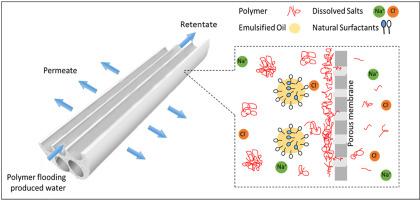Journal of Petroleum Science and Engineering Pub Date : 2020-10-15 , DOI: 10.1016/j.petrol.2020.108021 S.E. Weschenfelder , M.J.C. Fonseca , C.P. Borges

|
Polymeric additives are widely used in the oil and gas industry to increase the viscosity of the water injected into the reservoirs for enhancing oil recovery. This technique, also known as polymer flooding (PF), promotes the cogeneration of polymeric residues in the produced water stream. These residues cause an important efficiency reduction on the removal of oil and greases, by commonly used systems installed on offshore oil production platforms. Since ultrafiltration ceramic membranes have been considered as an improvement for designing more efficient treatment processes for new offshore installation units, the authors decided to conduct this work. The study aimed to assess the impact promoted by the presence of a polymer frequently used for PF on the performance of produced water treatment by an ultrafiltration ceramic membrane. For all the experimental conditions, it was observed that the selected membrane, with an average 0.1 μm pore size of, was able to generate a permeate stream with oil and greases concentration (CO) less than 5 mg/L. However, the polymer caused a significant impact on the membrane permeation flux, even when present in the saline samples at the concentration of 0.1 g/L. Under this condition, a reduction of 84% from the initial permeation flux (430 L/h.m2) was observed after 40 minutes of operation. Increasing the polymer concentration to 1.0 g/L resulted in an additional cutback of 9% from this value. When this sheared sample was prepared without salt, the permeation flux decrease was less intense, but still very significant. In this case, the final flux was 70 L/h.m2, representing a reduction of 83% from the initial value.
中文翻译:

陶瓷膜处理石油生产中聚合物驱产生的采出水
聚合物添加剂广泛用于石油和天然气行业,以增加注入储层中的水的粘度,从而提高采油率。此技术也称为聚合物驱(PF),可促进采出水流中聚合物残留物的热电联产。这些残留物会通过安装在海上采油平台上的常用系统而显着降低除油和除脂的效率。由于超滤陶瓷膜已被认为是为新型海上安装装置设计更有效的处理工艺的改进,因此作者决定进行此项工作。该研究旨在评估经常用于PF的聚合物的存在对超滤陶瓷膜对采出水处理性能的影响。O)小于5 mg / L。但是,即使以0.1 g / L的浓度存在于盐水样品中,聚合物也会对膜的渗透通量产生重大影响。在此条件下,运行40分钟后,观察到初始渗透通量(430 L / hm 2)降低了84%。将聚合物浓度增加到1.0 g / L会使该值再降低9%。当制备不含盐的剪切样品时,渗透通量下降的强度较小,但仍然非常显着。在这种情况下,最终通量为70 L / hm 2,与初始值相比减少了83%。











































 京公网安备 11010802027423号
京公网安备 11010802027423号